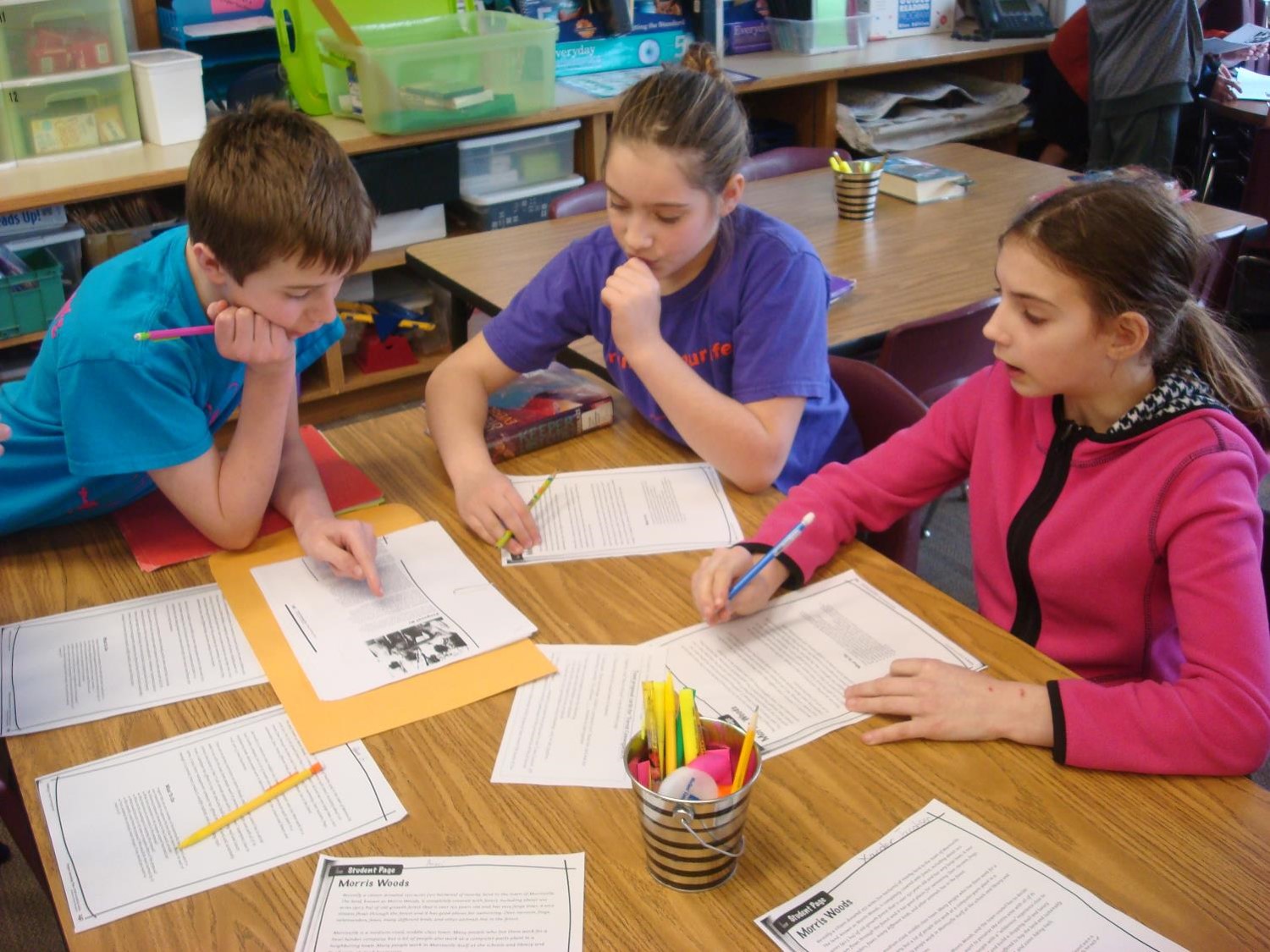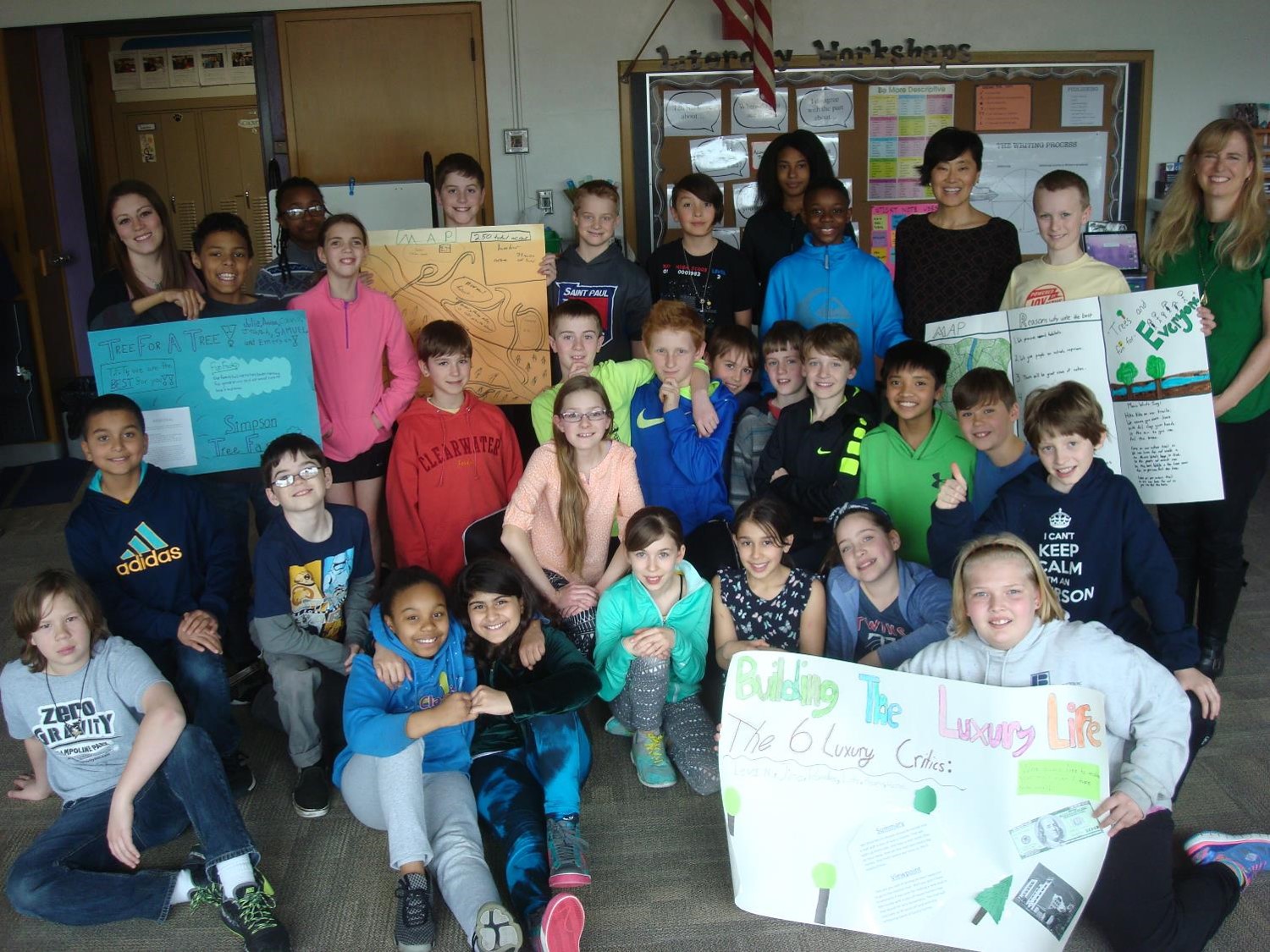 Imagine this scenario: A citizen generously donates 250 acres of forested land to your town.
Imagine this scenario: A citizen generously donates 250 acres of forested land to your town.
Your mission: Team with other citizens to create, propose, and present what you believe would be the best use of this land. Consider the needs of your town’s human, animal, and plant residents as well as local businesses, schools, and jobs. Pitch your proposal to your Town Council, whose members will vote on which one they believe is best suited to the needs of all involved.
Welcome to Forest Consequences, an activity in Project Learning Tree’s PreK-8 Environmental Education Activity Guide.
Students in a St. Paul, MN fifth grade class dived into this challenging cross-curricular unit with characteristic gusto! They worked in five teams of six students to develop creative and varied proposals to another class designated as the Town Council. Guiding this mission were homeroom teacher Ms. Tari Hella-Yelk, her student teacher Ms. Maggie Gleason, and science and literacy teacher Ms. Karen Christenson.
Forest Consequences is geared for use with middle school students and incorporates multiple subjects: Social studies, science, reading, writing, speaking, and listening to name a few.
Interested in giving it a go?
Here’s a chronological account of how we conducted this activity. Each of the eight sessions was approximately 40 minutes, but can be adjusted as needed.
 Session 1: The Big Picture
Session 1: The Big Picture
- Introduce the Big Picture and give an overview of the project;
- Read the “Morris Woods” Student Page together, highlighting key factors from the passage, e.g. that 100 acres are old-growth forest, that many plants and animals live there, that many townspeople work in the lumber industries, that the closest mall is an hour away, and so on;
- Review the project purpose and guidelines;
- Set the tone for respectful listening and thoughtful sharing. Model how to both speak and listen to differing opinions using another PLT activity, Viewpoints on the Line.
Session 2: Ground Rules and Accountable Talk
- Before beginning this lesson, it may be helpful for teachers to read Appendix 12 Teaching Controversial Issues on page 448 of the PLT PreK-8 Guide;
- Develop ground rules and expectations for true teamwork: What does teamwork look like? Sound like? Feel like?
- Practice accountable talk (ways to explain and support your opinions, to skillfully agree and disagree). Try using these speech bubbles provided by Saint Paul Schools;
- Together, reread the scenario outlined in the “Morris Woods” Student Page, discussing salient points about the old-growth forest, the local economy, etc.;
 Divide students into five equal teams. You may wish to consult Appendix 11 Successful Cooperative Learning Steps on page 447 of the PLT PreK-8 Guide to help form teams strategically;
Divide students into five equal teams. You may wish to consult Appendix 11 Successful Cooperative Learning Steps on page 447 of the PLT PreK-8 Guide to help form teams strategically; - Cut up and distribute the Proposals outlined in the “Morris Woods” Student Page. Here are some adaptations we made to build on this PLT activity:
- Team 1 presents Proposal 1 as-is, but also adds their own creative “flavor and flair” to the title, slogan, and details;
- Team 2 presents Proposal 2, adding their own flavor;
- Team 3 presents Proposal 3, adding their own flavor;
- Team 4 reads and reflects on all three proposals. Together, they decide what aspects are important to them. They may use elements of any of the three proposals to create one of their own.
- Team 5 is instructed to NOT read any of the three proposals. They are to reread the Morris Woods scenario and determine what factors are most important to them as they create their own unique proposal. This team has the most freedom but also the most decisions to make as they are starting from scratch.
Note: We recommend randomly assigning proposals to teams. Explain to students on teams 1, 2, and 3 that they may have been assigned a proposal with which they do not entirely agree. Explain to them that this is for the greater good of representing multiple community voices. Their job may include some “acting” to show their support for a particular aspect of the proposals.
Session 3: Rubric and Examples
- Review expectations for the teamwork, proposal, and presentation using this rubric;
- Show a few examples to illustrate multiple ways to highlight and present proposals: A map, a pros and cons poster, a song, and so on.
- Give students time to meet and read through their proposal and pitch initial ideas.
- Allow each team time and space to brainstorm ideas, themes, modes of communication, and tasks.
 Sessions 4-6: The Creative Flow
Sessions 4-6: The Creative Flow
Project Work Days
- Teams develop task lists and delegate members to their areas of expertise: Artwork, technology design, creative presentation development, etc.;
- Allow teams to dig in and create their masterpieces: I-Movies, posters, rap recordings, and more;
- Encourage student teams to review the rubric to see if they have met or exceeded the original guidelines;
- Give teams time to rehearse their presentations and work out any glitches.
Session 7: The Big Day!
 Presentations to the Town Council
Presentations to the Town Council
- Invite another class to come in to act as the Morrisville Town Council;
- Present Town Council members with a formal ballot, pencil, and clipboard;
- Instruct members that their role is to listen thoughtfully to each proposal before voting;
- Teams present!!
- Town Council casts their votes. Ballots are collected in a box and tallied, but not reported yet. We chose to keep the initial focus on the process and allow time for some “marinating” on what they had experienced, seen, and heard.
Session 8: Time to Debrief
- Before reporting the voting results, host a debriefing session with the whole class. Questions can be found under Step 7 of the Forest Consequences activity on page 139 in the PLT PreK-8 Guide.
- Gather student input: What did you notice? What worked well? What didn’t? Why? What might you like to do differently?
- Report the voting totals, reading aloud the Town Council’s reasoning for selecting the winning proposal.
Time to Wrap Up!
Students developed a plethora of creative ways to present their five proposals (see three of them on PLT’s YouTube channel): An I-Movie depicting what the woods could look like after development, a dance duo touting the merits of hiking trails, slides of a proposed mall and luxurious homes, a rap about “Trees and Fun for Everyone,” a map illustrating the benefits of rustic cabins and hiking trails, a nature education center with a touch and see room, and more. All of the groups integrated technology into their presentations in some way.
|
Team 3 created this iMovie in a fun and creative 1960s style to present their proposal for building a mall and luxury homes on the donated land. |
Another team also used their iPads to create an iMovie, advocating instead to keep Morris Woods as nature. |
These two 5th grade girls wrote their own choreographed song to support their proposal. |
 Afterward, we asked students how many would recommend this project for next year’s students. To our surprise, ALL of the students raised their hands! Here are just a few comments that provide insight into their enthusiastic response:
Afterward, we asked students how many would recommend this project for next year’s students. To our surprise, ALL of the students raised their hands! Here are just a few comments that provide insight into their enthusiastic response:
- “I thought Forest Consequences was a good mixture of challenge and fun. It really made you use your critical thinking skills to consider everything.”
- “This was a good chance to do some public speaking in front of another class.”
- “This gave us practice with persuasive writing and speaking, trying to get the Town Council to vote for us.”
- “I thought this was a fun process because you can really bring out your ideas and form them. You get a chance to show another group what you came up with.”
Resources on PLT.org
Log in for more resources to support PLT’s Forest Consequences activity, including the “Morris Woods” Student Pages in English and Spanish.

Karen Christenson is a science and literacy teacher with Saint Paul Public Schools in Minnesota and a National Project Learning Tree Outstanding Educator. She teamed with Tari Hella-Yelk, 5th grade teacher at St. Anthony Park Elementary, and Maggie Gleason, a student teacher, to teach this PLT activity to Ms. Hella-Yelk’s grade 5 class.


